





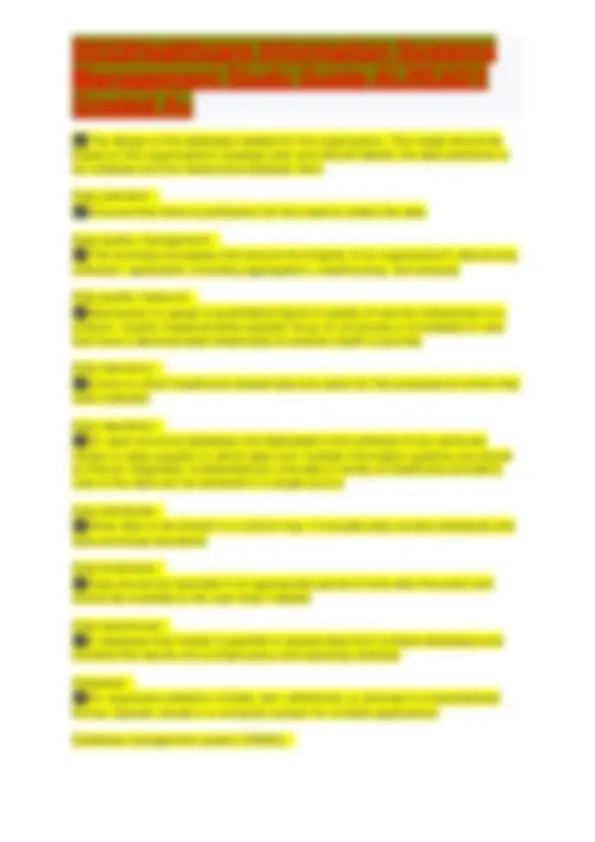
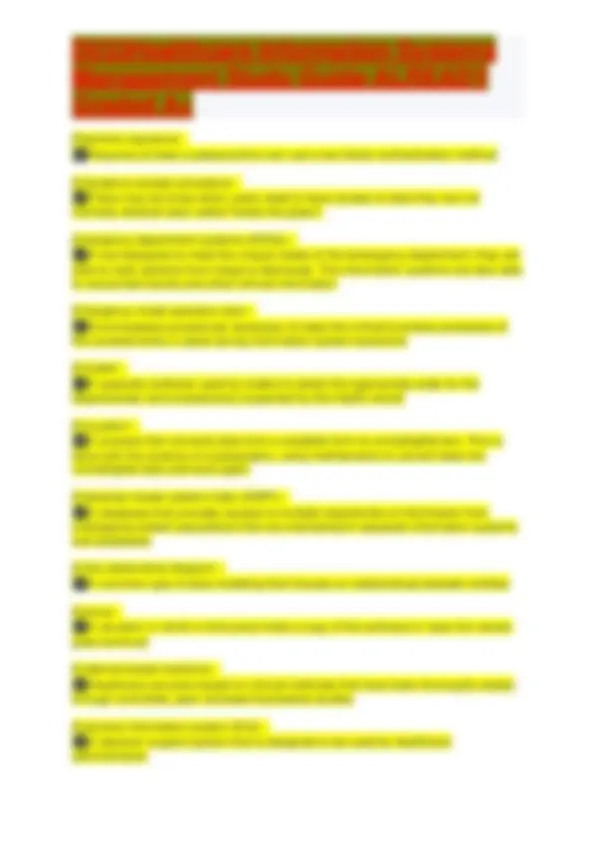
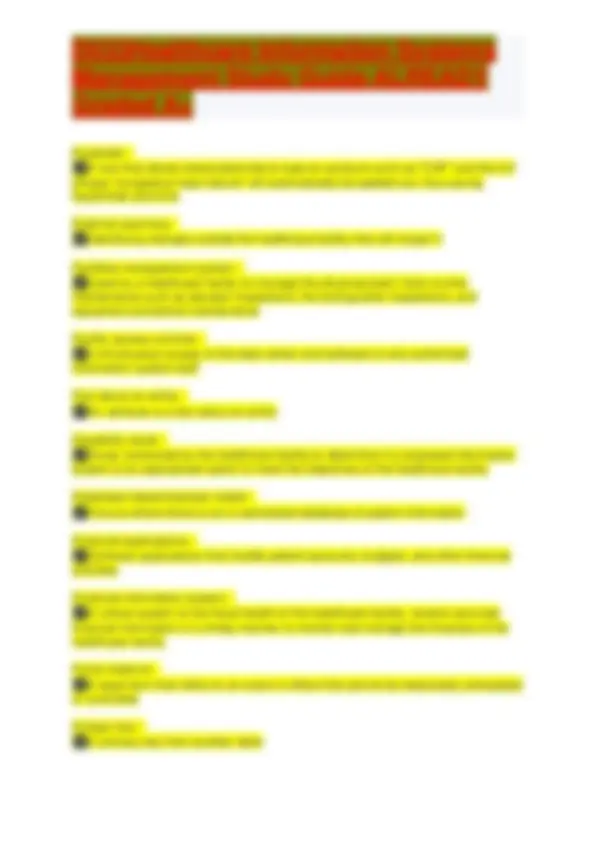

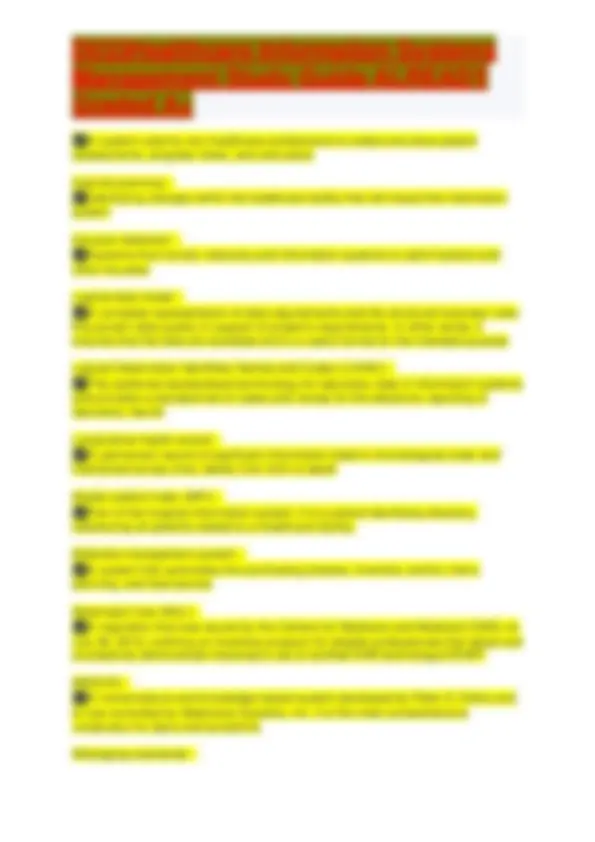
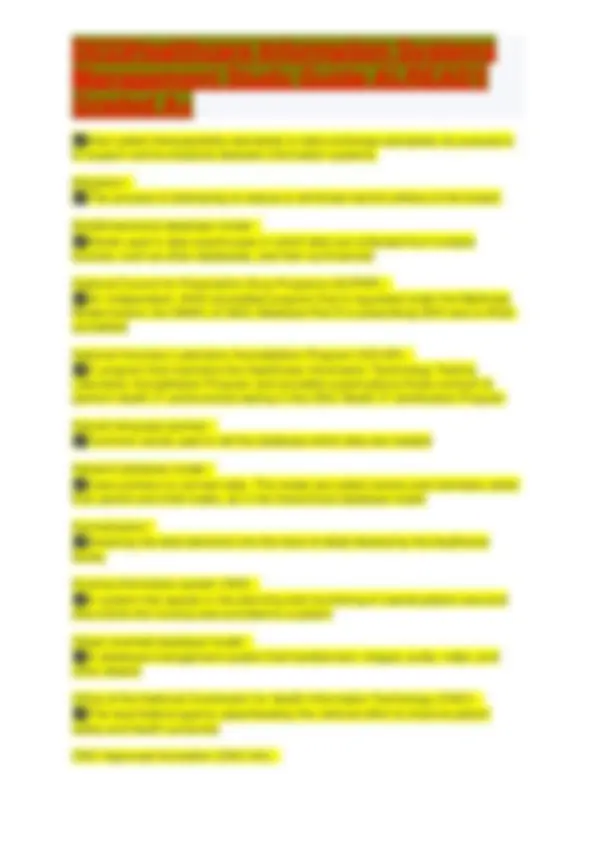

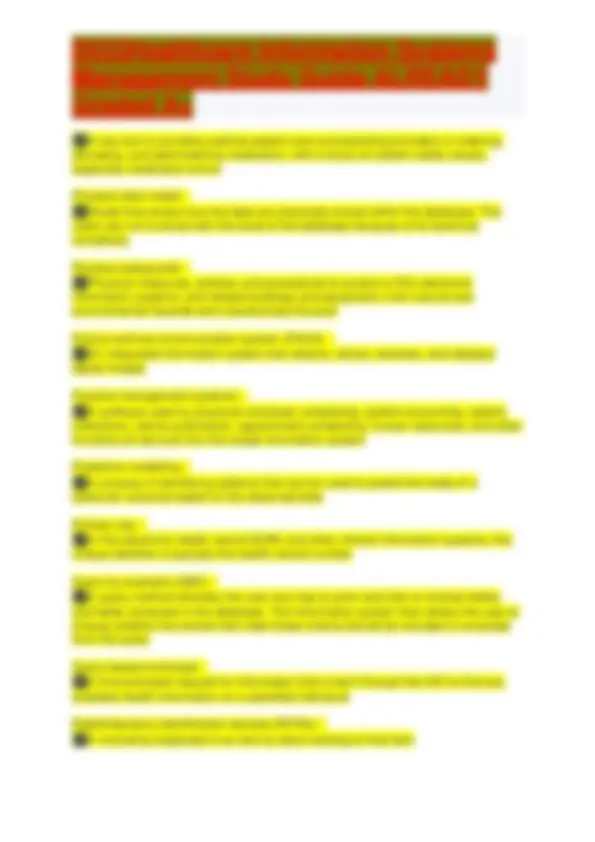

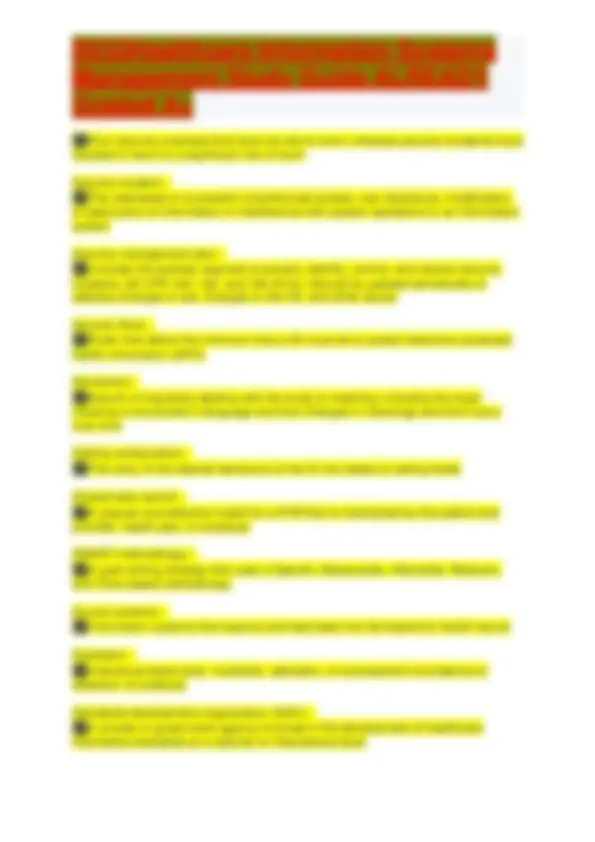
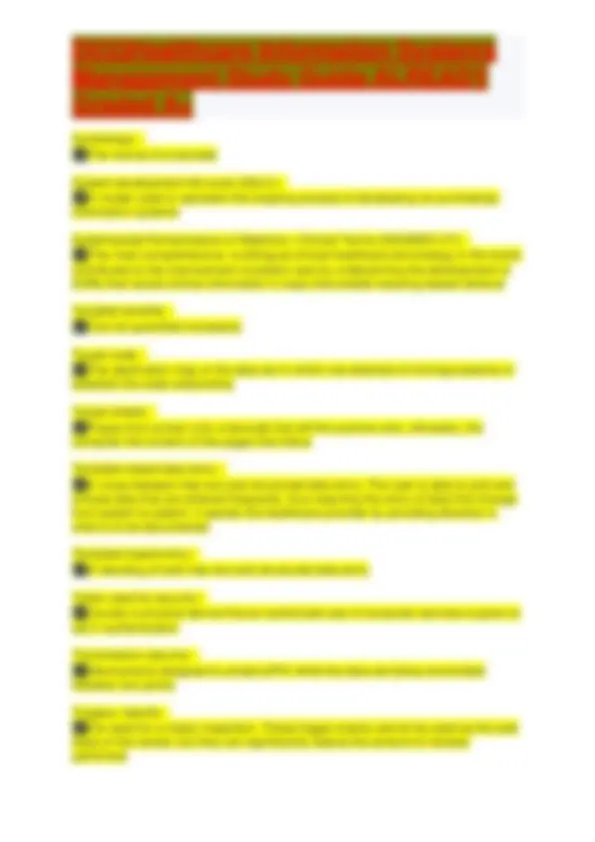




Study with the several resources on Docsity

Earn points by helping other students or get them with a premium plan


Prepare for your exams
Study with the several resources on Docsity

Earn points to download
Earn points by helping other students or get them with a premium plan
Community
Ask the community for help and clear up your study doubts
Discover the best universities in your country according to Docsity users
Free resources
Download our free guides on studying techniques, anxiety management strategies, and thesis advice from Docsity tutors
D033Healthcare Information Systems Management Study Guide ALREADY Graded A+.pdf
Typology: Exams
1 / 26

This page cannot be seen from the preview
Don't miss anything!



















Primary data sources - ✅ome directly from the original source, such as the patient when talking about symptoms or the reason for coming to the healthcare facility Secondary Data Sources - ✅Come from primary data sources such as health record Data Capture - ✅The process of recording healthcare-related data in a health record system or clinical database Acceptance testing: - ✅A type of testing that occurs after the go-live date Access controls: - ✅A computer software program designed to prevent unauthorized use of an information resource Addressable standards: - ✅Must be evaluated by the entity to determine whether or not the standard is reasonable and appropriate Administrative information system: - ✅A system that manages the business of healthcare;. The data collected in this system are mainly financial or business-oriented in nature, rather than clinical Administrative safeguards: - ✅Administrative actions, and policies and procedures, to manage the selection, development, implementation, and maintenance of security measure to protect electronic-protected health information and to manage the conduct of the covered entity's workforce in relation to the protection of that information. Administrative simplification: - ✅Improves the efficiency and effectiveness of the business processes of healthcare by standardizing the EDI of administrative and financial transactions and protects the privacy and security of protected health information (PHI) that is transmitted from one point to another
Alpha site: - ✅The first healthcare facility to implement the information system American Recovery and Reinvestment Act (ARRA): - ✅Enacted to stimulate the US economy during a recession that started in 2007. A significant portion of ARRA was dedicated to expanding the use of HIT to improve the business efficiency and effectiveness of HCOs while increasing patient safety and positive health outcomes. It also enacted an incentive program known as Meaningful Use Anesthesia information system: - ✅A system that collects information on preoperative, operative, and postoperative anesthesia-related clinical information. This system follows the patient through the surgical process Annotation: - ✅The ability to add to the image in some way; because the image may be a legal document, the image itself cannot be altered; however, an overlay to the document will show the annotation ANSI Accredited Standards Committee X12N (ASC X12N): - ✅Responsible for developing the EDI standards used to share information needed for health insurance administrative transactions Audit controls: - ✅The mechanisms that record and examine activity in information systems Audit log: - ✅Or audit trail, an electronic footprint of the actions that occurred in a particular file in an information system or that were performed by a specific individual Audit trails: - ✅The record of information system activities, such as log-in, log-out, unsuccessful log-ins, print, query, and other actions Audit-reduction tools: - ✅Tools that review the audit trail and compare it to criteria specified by the CE, which eliminates routine entries such as the periodic backups Authorship: - ✅The origination or creation of recorded information attributed to a specific individual or entity acting at a particular time
✅Healthcare practitioners using their personal smartphones or other devices rather than devices provided by the HCO, the personal device must meet specific encryption and other security protocols to protect PHI as required by the HCO Certified EHR technology: - ✅An EHR that has been evaluated by a member of the Office of the National Coordinator-Authorized Certification Bodies (ONC-ACBs) and verified that it meets the criteria set by the MU incentive programs Certified health data analyst (CHDA): - ✅Advanced certification sponsored by AHIMA that covers data management, data analytics, and data reporting Certified information security manager (CISM): Sponsored by ISACA; an international examination that is designed for leaders in security who oversee the security programs of organizations - ✅Credential that demonstrates advanced privacy and security skills. These advanced privacy and security skills exceed those in the RHIA or RHIT examinations. It is sponsored by AHIMA Certified information systems security professional (CISSP): - ✅Certification sponsored by the International Information Systems Security Certification Consortium. It is a generic security certification and therefore is not healthcare specific Change management: - ✅The formal process of introducing change, getting it adopted, and diffusing it throughout the healthcare facility Chargemaster: - ✅A financial management form or software that contains information about the healthcare facility's charges for the services it provides to patients (also called a charge description master [CDM]); it automates the coding process for routine procedures Chart deficiency system: - ✅A system that track and record documentation omission due to deficiency in the health record that comes to the HIM department. Deficiencies can be in paper, imaged, or electronic records depending on the information system used Clinical data repository (CDR): - ✅A centralized data repository Clinical decision support (CDS) system: -
✅The process in which individual data elements are represented in the computer by a special code to be used in making comparisons, trending results, and supplying clinical reminders and alerts Clinical document architecture (CDA): - ✅Standards developed by HL7 for the electronic exchange of clinical documents, such as discharge summaries and progress notes Clinical documentation improvement (CDI): - ✅The process an organization undertakes that will improve clinical specificity and documentation that will allow coding professionals to assign more concise disease and procedural classification codes Clinical information system (CIS): - ✅A system that collects and stores medical, nursing, clinical ancillary areas (such as radiology and laboratory), and therapy department information related to patient care Clinical messaging: - ✅A tool that connects the medical staff and hospital by providing access to information systems such as order entry and results reporting and DMS Clinical pathways - ✅A tool designed to coordinate multidisciplinary care planning for specific diagnoses and treatments Clinical practice guidelines: - ✅A tool that provides a detailed, step-by-step guide used by healthcare practitioners to make knowledge-based decisions related to patient care and issued by an authoritative organization such as a medical society Cloud computing: - ✅A computer system that is owned and maintained by a vendor Cluster map: - ✅An entry in a GEM where one code from the many target codes can become a map to the source code Code set: A set of codes used to encode data elements - ✅The types of mapping relations between source and target codes that exist in both forward and reverse directions Combination map: -
✅Also known as consumer health informatics; the field devoted to informatics from multiple consumer or patient views Consumer-mediated exchange: - ✅A type of HIE that is controlled by patients who want to control the use and access of their health information Content analyst: - ✅Individual who designs the clinical information system that will be implemented. Their work is directed by the needs of the users. They are also advocates in the usage of health information technology in healthcare Context-based authentication: - ✅Controls access not only by the role that the employee has in the CE but also by the individual data elements and the context in which the user is working Contingency plan: - ✅Plan that is made up of policies and procedures that identify how a CE will react in the event of an information system emergency such as power failure, natural disaster, or a system failure Continuity of Care Document (CCD): - ✅An implementation guide for sharing continuity of care record (CCR) patient summary data Continuity of care record (CCR): - ✅A core data set, which is the most relevant administrative, demographic, and clinical information about a patient's healthcare, covering one or more healthcare encounters Core data set: - ✅A data set that contains the most relevant administrative, demographic, and clinical information about a patient's healthcare Critical path: - ✅The sequence of stages that takes the longest amount of time to complete the project Dashboards: - ✅Reports of process measures to help leaders follow progress to assist with strategic planning. The dashboard provides the status on key measures Data accessibility: - ✅Data items can be easily obtainable by authorized users
Data accuracy: - ✅Data that are free of identifiable errors Data analyst: - ✅Individual who applies his or her skills to manage, analyze, interpret, and transform health data into accurate, consistent, and timely information Data analytics: - ✅The science of examining raw data with the purpose of drawing conclusions about that information. This information can then be used to make business decisions concerning which services to provide and how to improve patient care Data capture: - ✅The process of recording healthcare-related data in a health record system or clinical database Data cleansing: - ✅The process of checking internal consistency and duplication as well as identifying outliers and missing data. In other words, it means looking for errors or problems with the data, such as duplicate patients Data comprehensiveness: - ✅The patient's health record must be complete and all required data must be included Data consistency: - ✅Ensures that like data are the same on each document or computer screen Data content standards: - ✅Clear guidelines for the acceptable values for specified data fields. These standards make it possible to exchange health information using electronic networks, and they identify the structure and content of data elements to be collected by the EHR Data currency: - ✅Ensures that data are up to date Data definition language (DDL): - ✅A special type of software used to create the tables within a relational database. It translates how data are stored in the computer from the physical view (physical structure of the database) to the logical view (one that is understandable by the user) Data field: -
✅The design of the database needed for the organization. The model should be based on the organization's strategic plan and should identify the data elements to be collected and the relationship between them Data precision: - ✅Ensures that there is justification for the need to collect the data Data quality management: - ✅The business processes that ensure the integrity of an organization's data during collection, application (including aggregation), warehousing, and analysis Data quality measure: - ✅Mechanism to assign a quantitative figure to quality of care by comparison to a criterion. Quality measurements typically focus on structures or processes of care that have a demonstrated relationship to positive health outcomes Data relevancy: - ✅Extent to which healthcare-related data are useful for the purposes for which they were collected Data repository: - ✅An open-structure database (not dedicated to the software of any particular vendor or data supplier) in which data from multiple information systems are stored so that an integrated, multidisciplinary (includes a variety of healthcare providers) view of the data can be achieved in a single source Data standards: - ✅Allow data to be shared in a uniform way. It includes data content standards and data exchange standards Data timeliness: - ✅Data should be recorded in an appropriate period of time after the event and should be available to the user when needed Data warehouse: - ✅A database that makes it possible to access data from multiple databases and combine the results into a single query and reporting interface Database: - ✅An organized collection of data, text, references, or pictures in a standardized format, typically stored in a computer system for multiple applications Database management system (DBMS): -
✅Manipulates and controls the data stored within the database to meet the needs of the user; it controls the ability to create, read, write, and delete data stored in the database Database table: - ✅Table that contains all data related to a particular subject or concept such as a patient and is made up of the records and fields Decision support system (DSS): - ✅An information system that gathers data from a variety of sources and assists in providing structure to the data by using various analytical models and visual tools in order to facilitate and improve the ultimate outcome in decision-making tasks associated with the nonroutine and nonrepetitive problems Degaussing: - ✅Application of a magnetic field to the media to render the data on it useless; it renders data impossible to recover and is not reversible Descriptive statistics: - ✅A set of statistical techniques used to describe data such as means, frequency distributions, and standard deviations Designated standard maintenance organizations (DSMOs): - ✅Six organizations to which the Department of Health and Human Services (HHS) has assigned of developing and maintaining standards for the Transaction and Code Sets rule Digital Imaging and Communications in Medicine (DICOM): - ✅Standard retrieves images and other information from imaging equipment of a variety of different vendors. Although DICOM started out in diagnostic medical imaging, it has broadened to include specialties such as cardiology, dentistry, and radiology Directed exchange: - ✅Frequently referred to as a "push exchange" because it pushes authorized and secure information from one HCO to another Director of clinical informatics: - ✅Individual who is the leader in the implementation of the EHR as well as the post- implementation services. The director is the champion for the EHR and works with the implementation team to ensure they have the resources needed Disclosure management system: -
Electronic signature: - ✅Requires at least a password but can use a two-factor authentication method Emergency access procedure: - ✅There may be times when users need to have access to data they are not normally allowed (also called "break the glass") Emergency department systems (EDSs): - ✅A tool designed to meet the unique needs of the emergency department; they are able to track patients from triage to discharge. The information systems are also able to record test results and other clinical information Emergency mode operation plan: - ✅Encompasses procedures necessary to keep the critical business processes of the covered entity in place during information system downtime Encoder: - ✅A specialty software used by coders to select the appropriate code for the diagnosis(es) and procedure(s) supported by the health record Encryption: - ✅A process that converts data from a readable form to unintelligible text. This is done with the science of cryptography, using mathematics to convert data into unintelligible data and back again Enterprise master patient index (EMPI): - ✅A database that provides access to multiple repositories of information from overlapping patient populations that are maintained in separate information systems and databases Entity-relationship diagram: - ✅A common type of data modeling that focuses on relationships between entities Escrow: - ✅A situation in which a third party holds a copy of the software in case the vendor goes bankrupt Evidence-based medicine: - ✅Healthcare services based on clinical methods that have been thoroughly tested through controlled, peer-reviewed biomedical studies Executive information system (EIS): - ✅A decision support system that is designed to be used by healthcare administrators
Expander: - ✅A tool that allows transcriptionists to type an acronym such as "CHF" and the full phrase "congestive heart failure" will automatically be spelled out, thus saving keystrokes and time External scanning: - ✅Identifying changes outside the healthcare facility that will impact it Facilities management system: - ✅Used by a healthcare facility to manage the physical plant; track routine maintenance such as elevator inspections, fire extinguisher inspections, and equipment preventive maintenance Facility access controls: - ✅Limit physical access to the data center and software to only authorized information system staff Fact about an entity: - ✅An attribute is a fact about an entity Feasibility study: - ✅Study conducted by the healthcare facility to determine if a proposed information system is an appropriate option to meet the objectives of the healthcare facility Federated (decentralized) model: - ✅Occurs where there is not a centralized database of patient information Financial applications: - ✅Software applications that handle patient accounts, budgets, and other financial activities Financial information system: - ✅A critical system to the fiscal health of the healthcare facility; receive accurate financial information in a timely manner to monitor and manage the finances of the healthcare facility Force majeure: - ✅A legal term that refers to an event or effect that cannot be reasonably anticipated or controlled Foreign key: - ✅A primary key from another table
entities or patients for the electronic creation, maintenance, access, or exchange of health information - ✅A public-private partnership organization that oversees, governs, and facilitates the transmission of health data between different types of HCOs that have various EHR systems, according to nationally recognized standards. Many HIOs started as local health information Health Information Technology for Economic and Clinical Health (HITECH) Act: - ✅Promotes the adoption and meaningful use of health information technology (Health IT) and provides additional privacy and security requirements that develop and support electronic health information, facilitate information exchange, and strengthen monetary penalties Health Insurance Portability and Accountability Act of 1996 (HIPAA): - ✅A federal law that impacts many areas of healthcare, including insurance portability, code sets, privacy, security, electronic data interchange (EDI), and national identifier standards Health Level Seven International (HL7): - ✅A not-for-profit ANSI-accredited SDO dedicated to providing a comprehensive framework and related standards for the exchange, integration, sharing, and retrieval of electronic health information that supports clinical practice and the management, delivery, and evaluation of health services Healthcare clearinghouse: - ✅Companies that function as intermediaries who collect billing data and process it for the healthcare provider. The healthcare clearinghouse then submits the claim to the health plan for payment Healthcare quality indicator system: - ✅An abstracting system that records information about the patient, the care provided to the patient, and the healthcare practitioner(s) involved in the care delivered Hierarchical database model: - ✅Model that structures the data in a hierarchy very similar to that used for an organizational chart Hospital information system: - ✅The major information system used by a healthcare facility; is made up of many administrative systems, such as the financial information system and the MPI Hot spot: -
✅Is a type of help message that is triggered when the cursor is placed on top of a data field Hybrid model: - ✅A combination of the advantages of centralized and decentralized models; has an RLS, and some data are stored in a central repository while the remainder stays with the other HCOs within the HIE Identity management: - ✅Ensures that the individual who has been identified is who they say they are, that they have the authority to do what they want to do, and that their actions are tracked Identity matching: - ✅Also known as patient matching, the process in which the HIO identifies the right person within the database to exchange information between HCOs Inferential statistics: - ✅A set of statistical techniques that allows researchers to make generalizations about a population's characteristics on the basis of a sample's characteristics, such as HIM professionals' continuing education efforts Information access management: - ✅Involves implementing policies and procedures to determine which employees have access to what information Information system activity review: - ✅Monitors for the inappropriate use or disclosure of ePHI. HIPAA does not mandate the frequency of this review nor the way this review is to be conducted. These reviews should include logs, access, and incident reporting Information system strategic planning: - ✅Plan that identifies information systems needed to meet the healthcare facility's business objectives Information system trainer: - ✅Individual who is responsible for the development and implementation of the training plan Information systems project steering committee: - ✅Group of staff members responsible for every information system acquisition project in the healthcare facility Interdisciplinary charting systems: -
✅Also called interoperability standards or data exchange standards; its purpose is to support communications between information systems. Mitigation: - ✅The process of attempting to reduce or eliminate harmful effects of the breach Multidimensional database model: - ✅Model used in data warehouses in which data are collected from multiple sources, such as other databases, and then summarized National Council for Prescription Drug Programs (NCPDP): - ✅An independent, ANSI-accredited program that is regulated under the Medicare Modernization Act (MMA) of 2003, Medicare Part D e-prescribing SDO and is ANSI- accredited National Voluntary Laboratory Accreditation Program (NVLAP): - ✅A program that maintains the Healthcare Information Technology Testing Laboratory Accreditation Program and accredits organizations those contract to perform health IT conformance testing in the ONC Health IT Certification Program Natural language queries: - ✅Common words used to tell the database which data are needed Network database model: - ✅Uses pointers to connect data. The nodes are called owners and members rather than parent and child nodes, as in the hierarchical database model Normalization: - ✅Breaking the data elements into the level of detail desired by the healthcare facility Nursing information system (NIS): - ✅A system that assists in the planning and monitoring of overall patient care and documents the nursing care provided to a patient Object-oriented database model: - ✅A database management system that handles text, images, audio, video, and other objects Office of the National Coordinator for Health Information Technology (ONC): - ✅The lead federal agency spearheading this national effort to improve patient safety and health outcomes ONC-Approved Accreditor (ONC-AA): -
✅An entity designated by the ONC to accredit and oversee the certification bodies (ONC-ACBs) One-factor authentication: - ✅Utilizes one level of access control such as a username and password Online analytical processing (OLAP): - ✅A data access architecture that allows the user to retrieve specific information from a large volume of data Opt-in or opt-out consent: - ✅Sets the default for health information of patients to be included in the HIO automatically (opt-in), but the patient can choose not to be included (opt-out) completely. Opt-in consent means that the patient must specifically agree to have the personal health information accessible for the HIE Order entry and results reporting: - ✅A software application in which healthcare professionals can enter patient care orders and then see the test results Open-structure database: - ✅A data repository is created in an open format so it is not tied to any system Parent and child: - ✅The relationships of a hierarchical database model is parent to child Patient monitoring systems: - ✅A system that automatically collects and stores patient data from various information systems used in healthcare. Data collected include fetal monitoring, vital signs, and oxygen saturation rates Payment milestones: - ✅An action that triggers payment to the vendor Personal health record (PHR): - ✅An electronic or paper health record maintained and updated by individuals that can be used to collect, track, and share past and current information about their health or the health of someone in their care PERT chart: - ✅A management tool that evaluates the tasks, the dependencies on other activities, the activity sequence, and the time required to complete the task Pharmacy information system (PIS): -